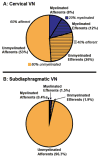Effects of vagal neuromodulation on feeding behavior
- PMID: 29425906
- PMCID: PMC6003853
- DOI: 10.1016/j.brainres.2018.02.003
Effects of vagal neuromodulation on feeding behavior
Abstract
Implanted vagus nerve stimulation (VNS) for obesity was recently approved by the FDA. However, its efficacy and mechanisms of action remain unclear. Herein, we synthesize clinical and preclinical effects of VNS on feeding behavior and energy balance and discuss engineering considerations for understanding and improving the therapy. Clinical cervical VNS (≤30 Hz) to treat epilepsy or depression has produced mixed effects on weight loss as a side effect, albeit in uncontrolled, retrospective studies. Conversely, preclinical studies (cervical and subdiaphragmatic VNS) mostly report decreased food intake and either decreased weight gain or weight loss. More recent clinical studies report weight loss in response to kilohertz frequency VNS applied to the subdiaphragmatic vagi, albeit with a large placebo effect. Rather than eliciting neural activity, this therapy putatively blocks conduction in the vagus nerves. Overall, stimulation parameters lack systematic exploration, optimization, and justification based on target nerve fibers and therapeutic outcomes. The vagus nerve transduces, transmits, and integrates important neural (efferent and afferent), humoral, energetic, and inflammatory information between the gut and brain. Thus, improved understanding of the biophysics, electrophysiology, and (patho)physiology has the potential to advance VNS as an effective therapy for a wide range of diseases.
Keywords: Energy balance; Feeding behavior; Neural engineering; Obesity; Vagus nerve stimulation; Weight loss.
Copyright © 2018 Elsevier B.V. All rights reserved.
Figures


References
-
- Hampton T. Electric stimulation device approved to treat obesity. JAMA. 2015;313:785. doi: 10.1001/jama.2015.234. - DOI
-
- Ogden CL, Carroll MD, Fryar CD, Flegal KM. Prevalence of childhood and adult obesity in the United States, 2011–2014. CDC - NCHS Data Brief. 2015;219:1–8. - PubMed
-
- Obesity and overweight - Fact sheet. WHO; 2016. [accessed October 9, 2017]. http://www.who.int/mediacentre/factsheets/fs311/en/
Publication types
MeSH terms
Substances
Grants and funding
LinkOut - more resources
Full Text Sources
Other Literature Sources

